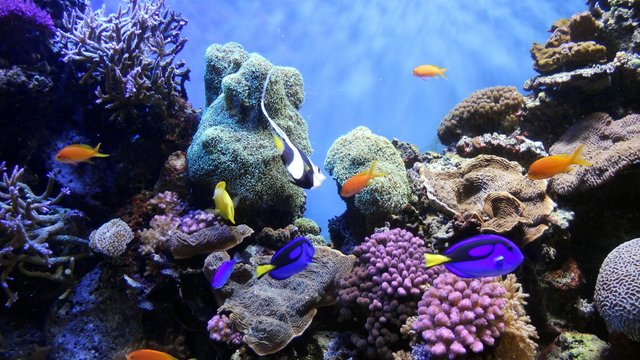How Diversity Enhances Productivity: Complementarity and Comparative Advantage
Complementarity, from Ecology
Complementarity occurs because evolution has resulted in different species, each specialized for different environmental conditions. It is one major reason why a diverse community (group of species sharing common resources) is in many cases more productive than the sum of its member species in isolation.
This image from Wikimedia shows many fish near a coral reef, where complementarity enhances productivity because of the interactions between the coral and the diverse communities of bacteria, plankton and fish.

Spatial Complementarity
Spatial complementarity refers to adaptation for different locations. For example, some plankton are well known to be adapted to grow at different water depths. This is because there is typically a strong gradient in environmental conditions over depth, from the surface to deeper layers in the ocean and in lakes: light and temperature tend to decrease with increasing depth, whereas nutrient levels tend to increase with depth. For example, differences in the light harvesting ability of different phytoplankton are well known.
Temporal Complementarity
Evolution has also produced different species adapted to different conditions throughout the seasonal cycle. This is obvious to anyone who keeps a vegetable garden, even though domesticated plants have in many cases also been greatly modified by humans through selective breeding, For example, tomatoes will not grow well in cold winter conditions, and broccoli will not do well in the hot summertime. Similarly, some plankton have evolved to do well during cool, nutrient-rich conditions (for example, diatoms such as chaetoceros), whereas other, smaller species tend to dominate in warm, low-nutrient waters (for example, tiny prochlorococus, which has strains adapted for both high- and low-light conditions).
Interactions are Essential
Although different plankton typically dominate at different depths, they are still considered part of the same community because they interact through their shared dependence on the nutrients dissolved in the water, by having common predators, and because those in the upper layers can sometimes shade out a significant amount of light, limiting the growth of those below them. These interactions are important determinants of both biodiversity and overall productivity, just as trade is important to enhancing our standard of living as humans (below).
For more about complementarity, please see my previous post Competition, Cooperation, and Complementarity.
Comparative Advantage, from Economics
An important concept in economics, Comparative Advantage means that even if for example a very productive and highly paid executive also happens to be an unusually good driver, that executive can still benefit by hiring someone else to drive him or her around. This is because hiring the driver allows that executive to spend more time talking to colleagues on the phone, or making executive decisions, or simply resting, which he or she could not do while driving. Hiring a driver may in fact enhance the executive’s productivity, and increase earnings, enough to pay the driver many times over. Thus specialization can offer benefits even to those more skilled at a task than the employees they hire to perform it. This enhances overall productivity and benefits the employees hired to do those tasks as well as those who hire them.
Both temporal and spatial constraints on individuals create opportunities for such comparative advantage. During a busy week, our hypothetical executive may not have time to do laundry and iron shirts. In order to operate a business with many employees working in multiple regions using different languages, it will most likely be more productive to hire managers fluent in each language and familiar with each culture, rather than have one person or small group make all management decisions.
Comparative advantage is also vital to understanding the multiplicative benefits of combining specialization with trade. The presentation below explains this point very well.
S. Lan Smith
Kamakura, Japan
September 2, 2016
hi! @lanimal i love your work on ecology :-) are you on steemit.chat?
Thank you. Not yet, but I have been meaning to sign up and try Steemit.chat.
Upvoted and now following you. I especially like the mixing of concepts from biology and economics, which I posted about here.
https://steemit.com/economics/@plotbot2015/oc-magazine-review-evonomics